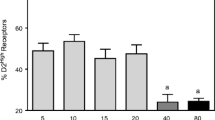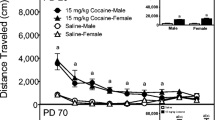Abstract
The effects of chronic haloperidol administration during the prenatal and preweanling periods on dopamine autoreceptor function were examined in striatum, olfactory tubercles, and nucleus accumbens of young (2–3 month) and older (12–13 month) adult rats. In striatum of young and older adult rats that had been chronically treated with haloperidol early in life, as well as in the nucleus accumbens of older adults receiving early chronic haloperidol, gamma-butyrolactone (GBL) did not induce significant increases in dopamine levels. In olfactory tubercles of young adults that had received early chronic treatment with haloperidol, apomorphine pretreatment failed to reverse the observed GBL-induced increase in dopamine levels. Thus, dopamine autoreceptor function appears to be attenuated in rats chronically treated with haloperidol during early development, in contrast to reports of autoreceptor supersensitivity following neuroleptic treatment in adulthood.
Similar content being viewed by others
References
Adams J, Buelke-Sam J (1981) Behavioral assessment of the postnatal animal: testing and methods development. In: Kimmel CA, Buelke-Sam J (eds) Developmental Toxicology. Raven Press, New York, pp 223–258
Agrawal HC, Glisson SN, Himwich WA (1966) Changes in monoamines of rat brain during post-natal ontogeny. Biochem Biophys Acta 130:511–513
Anden N, Grabowska-Anden M, Lindgren S, Thornstrom U (1983) Synthesis rate of dopamine: difference between corpus striatum and limbic system as a possible explanation of variations in reactions to drugs. Naunyn-Schmiedeberg's Arch Pharmacol 323:193–198
Asper H, Baggiolini M, Burki H, Lauener H, Ruch W, Stille G (1973) Tolerance phenomena with neuroleptics: Catalepsy, apomorphine stereotypies and striatal dopamine metabolism after single and repeated administration of loxapine and haloperidol. Eur J Pharmacol 22:287–294
Bannon MJ, Michaud RL, Roth RH (1981) Mesocortical dopamine neurons: lack of autoreceptors modulating dopamine synthesis. Mol Pharmacol 19:270–275
Beart PM, Gundlach AL (1980) 3,4-dihydroxyphenylacetic acid (DOPAC) and the rat mesolimbic dopaminergic pathway: drug effects and evidence for somatodendritic mechanisms. Br J Pharmacol 69:241–247
Biswas B, Carlsson A (1977) The effect of intracerebroventricularly administered GABA on brain monoamine metabolism. Naunyn-Schmiedeberg's Arch Pharmacol 299:41–46
Calderini G, Bonetti AC, Aldino A, Savoini G, Di Perri B, Biggio G, Toffano G (1981) Functional interaction between benzodiazepine and GABA recognition sites in aged rats. Neurobiol Aging 2:309–313
Chang CC (1964) A sensitive method for spectrophotofluormetric assay of catecholamines. Int J Pharmacol 3:643–649
Cuomo V, Cattabeni F, Racagni G (1983) The influence of early postnatal treatment with haloperidol on the effects induced by small and large doses of apomorphine on locomotion of adult rats. Neuropharmacology 22:1137–1139
Demarest KT, Lawson-Wendling KL, Moore KE (1983) D-amphetamine and gamma-butyrolactone alteration of dopamine synthesis in the terminals of nigrostriatal and mesolimbic neurons. Biochem Pharmacol 32:691–697
Di Chiara G, Corsini GU, Mereu GP, Tissari A, Gessa GL (1978) Self-inhibitory dopamine receptors: their role in the biochemical and behavioral effects of low doses of apomorphine. In: Roberts PJ et al. (eds) Advances in Biochemical Psychopharmacology, vol 19. Raven Press, New York, pp 275–292
Earley CJ, Leonard BE (1978) Isolation and assay of noradrenaline, dopamine, 5-hydroxy-tryptamine, and several metabolites from brain tissue using disposable Bio-Rad Columns packed with Sephadex G-10. J Pharmacol Meth 1:67–79
Gianutsos G, Hynes M, Drawbaugh R, Lal H (1978) Similarities and contrasts between the effects of amphetamine and apomorphine in rats chronically treated with haloperidol. Prog Neuropsychopharmacol 2:161–167
Govoni S, Spano PF, Trabucchi M (1978) [3H]-Haloperidol and [3H]spiroperidol binding in rat striatum during aging. J Pharm Pharmacol 30:448–449
Gudelsky GA, Moore KE (1976) Differential drug effects on dopamine concentrations and rates of turnover in the median eminence, olfactory tubercle and corpus striatum. J Neural Transm 38:95–105
Hicks P, Strong R, Schoolar JC, Samorajski T (1980) Aging alters amphetamine-induced stereotyped gnawing and neostriatal elimination of amphetamine in mice. Life Sci 27:715–722
Lawson K, Demarest K, Moore K (1981) Differences in the effects of d-amphetamine and gamma-butyrolactone on dopamine synthesis in striatum and nucleus accumbens. Fed Proc 40:312
Lerner P, Nose P (1977) Haloperidol: effect of long-term treatment on rat striatal dopamine synthesis and turnover. Science 1:181–183
Liljequist S, Engel J (1980) Effect of ethanol on central gabaergic mechanisms. In: Eriksson K et al. (eds) Animal Models in Alcohol Research. Academic Press, London, pp 309–315
Lowry OH, Rosenbrough NJ, Farr AL, Randall RJ (1951) Protein measurement with the Folin phenol reagent. J Biol Chem 193:266–275
Nowycky MC, Roth RH (1978) Dopaminergic neurons: role of presynaptic receptors in the regulation of transmitter biosynthesis. Prog Neuro-Psychopharmacol 2:139–158
Pohorecky L, Newman B, Sun J, Bailey W (1978) Acute and chronic ethanol ingestion and serotonin metabolism in rat brain. J Pharmacol Exp Ther 204:424–443
Purves D, Lichtman J, (1978) Formation and maintenance of synaptic connections in autonomic ganglia. Physiol Rev 58:861–862
Rosengarten H, Friedhoff A (1979) Enduring changes in dopamine receptor cells of pups from drug administration to pregnant and nursing rats. Science 203:1133–1135
Rosengarten H, Friedman E, Friedhoff AJ (1983) Sensitive period for the effect of haloperidol on development of striatal dopamine receptors. In: Haber B, Perez-Polo SR, Hashim GA, Stella AMG, Paul NW (eds) Nervous System Regeneration. Birth Defects: Original Article Series, Volume 19, Number 4, Allan R. Liss, Inc., New York, pp 511–513
Roth RH (1979) Dopamine autoreceptors: pharmacology, function and comparison with post-synaptic dopamine receptors. Commun Psychopharmacol 3:429–445
Shalaby IA, Spear LP (1980) Chronic administration of haloperidol during development: later psychopharmacological responses to apomorphine and arecoline. Pharmacol Biochem Behav 13:685–690
Spear LP (1984) Age at the time of testing reconsidered in neurobehavioral teratological research. In: Yanai J (ed) Neurobehavioral Teratology, Elsevier Science Publishers, Amsterdam, pp 315–328
Spear P, Shalaby IA, Brick J (1980) Chronic administration of haloperidol during development: behavioral and psychopharmacological effects. Psychopharmacology 70:47–58
Springer J, Hannigan Jr JH, Isaacson RL (1981) Changes in dopamine and DOPAC following systemic administration of apomorphine and 3,4-dihydroxyphenylamino-2-imidazoline (DPI) in rats. Brain Res 220:226–230
Spyker JM (1975) Assessing the impact of low level chemicals on development: behavioral and latent effects. Fed Proc 34:1835–1844
Strong R, Samorajski T, Gottesfeld Z (1982) Regional mapping of neostriatal neurotransmitter systems as a function of aging. J Neurochem 39:831–836
Thornburg J, Moore K (1975) Supersensitivity to dopaminergic agonists induced by haloperidol. NIDA Research Monograph Series 3:23–28
Walters JR, Roth RH (1974) Dopaminergic neurons: drug-induced antagonism of the increase in tyrosine hydroxylase activity produced by cessation of impulse flow. J Pharmacol Exp Ther 191:82–91
Westfall TC, Naes L, Paul C (1983) Relative potency of dopamine agonists on autoreceptor function in various brain regions of the rat. J Pharmacol Exp Ther 224:199–205
Author information
Authors and Affiliations
Additional information
This research was supported in part by National Institute of Mental Health Grant R01MH35761 and a BRSG Grant S07RR07149-09 awarded by the Biomedical Research Support Grant Program, Division of Research Resources, National Institutes of Health.
Rights and permissions
About this article
Cite this article
Scalzo, F.M., Spear, L.P. Chronic haloperidol during development attenuates dopamine autoreceptor function in striatal and mesolimbic brain regions of young and older adult rats. Psychopharmacology 85, 271–276 (1985). https://doi.org/10.1007/BF00428186
Received:
Accepted:
Issue Date:
DOI: https://doi.org/10.1007/BF00428186




